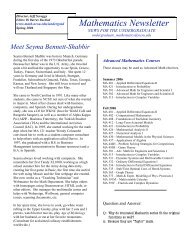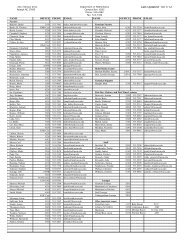A Proof of the Monotone Column Permanent (MCP) Conjecture for ...
A Proof of the Monotone Column Permanent (MCP) Conjecture for ...
A Proof of the Monotone Column Permanent (MCP) Conjecture for ...
Create successful ePaper yourself
Turn your PDF publications into a flip-book with our unique Google optimized e-Paper software.
that<br />
∀ξ1, . . . , ξn ∈ R: p(ξ1, . . . , ξn) ≮ 0 (p is [positive semi-] definite)<br />
(1)<br />
∃u0, . . . , um ∈ K[X1, . . . , Xn]: p(X1, . . . , Xn) =<br />
⇕<br />
lX<br />
i=1<br />
„ ui<br />
u0<br />
« 2<br />
,<br />
where K = R or K = Q and p ∈ K[X1, . . . , Xn] or p ∈<br />
K(X1, . . . , Xn).<br />
For a chosen denominator degree δ, to prove a polynomial<br />
p ∈ Q[X1, . . . , Xn] positive semidefinite, we can apply SDP<br />
to solve <strong>the</strong> following SOS program:<br />
inf Trace(W)<br />
W<br />
s. t. p(X) = m∆(X)T W [1] m∆(X)<br />
mδ(X) T W [2] » mδ(X)<br />
[1]<br />
W 0<br />
W =<br />
0 W [2]<br />
–<br />
, W � 0, W T = W.<br />
Here m∆(X), mδ(X) denote <strong>the</strong> vectors <strong>of</strong> monomial terms<br />
<strong>of</strong> degree no more than ∆ and δ, respectively.<br />
For <strong>the</strong> fixed degree δ, <strong>the</strong> SOS program (2) can be solved<br />
efficiently by algorithms in GloptiPoly [3], SOSTOOLS [11],<br />
YALMIP [8] and SeDuMi [13]. However, since we are running<br />
fixed precision SDP solvers in Matlab, we can only<br />
obtain numerical positive semidefinite matrices W [1] , W [2]<br />
which satisfy approximately<br />
9<br />
>=<br />
>;<br />
(2)<br />
p(X) ≈ m∆(X)T W [1] m∆(X)<br />
mδ(X) T W [2] mδ(X) , W [1] � 0 , W [2] � 0. (3)<br />
The polynomial p can be certified as non-negative if f W [1] , f W [2]<br />
satisfy <strong>the</strong> following conditions exactly:<br />
p(X) = m∆(X)T f W [1] m∆(X)<br />
mδ(X) T f W [2] mδ(X) , f W [1] � 0 , f W [2] � 0. (4)<br />
In [7], we start with finding a rational positive semidefinite<br />
matrix f W [2] near to W [2] by solving <strong>the</strong> SOS program (2),<br />
<strong>the</strong>n <strong>for</strong> <strong>the</strong> fixed denominator, we use Gauss-Newton iterations<br />
to refine <strong>the</strong> matrix W [1] . The rational positive<br />
semidefinite symmetric matrix f W [1] which satisfies (4) exactly<br />
can be computed by orthogonal projection ( f W [1] is <strong>of</strong><br />
full rank) or rational vector recovery ( f W [1] is singular).<br />
Lemma 1. The polynomial p1,3, which has 53 monomials,<br />
can be written as polynomial SOS with 10 polynomials.<br />
Let δ = 0 and W [2] = [1], by solving <strong>the</strong> SOS program (2),<br />
we obtain a 29 × 29 numerical positive semidefinite matrix<br />
W [1] . After rounding <strong>the</strong> entries <strong>of</strong> W [1] to integers and<br />
computing its exact LDL T -decomposition, we can write p1,3<br />
as an SOS <strong>of</strong> 10 polynomials:<br />
p1,3 = 1<br />
12 g2 1+g 2 2+ 1<br />
2 g2 3+ 1<br />
4 g2 4+ 1<br />
4 g2 5+ 1<br />
2 g2 6+ 1<br />
2 g2 7+g 2 8+ 1<br />
2 g2 9+g 2 10,<br />
where<br />
g1 = 12 xy + 6 yb 2 + 12 ya 2 + 6 xe 2 + 6 b 2 d 2 + 12 xd 2<br />
+6 a 2 e 2 + 12 a 2 d 2 ,<br />
g2 = yb 2 −xe 2 +b 2 d 2 −a 2 e 2 , g3 = 2 yab+2 abe 2 +2 abd 2 ,<br />
g4 = 4 yac+2 ace 2 +4 acd 2 , g5 = 4 xdf +2 b 2 df +4 a 2 df,<br />
g6 = 2 xde + 2 b 2 de + 2 a 2 de, g7 = 2 ybc + 2 bcd 2 ,<br />
66<br />
g8 = bcde, g9 = 2 xef + 2 a 2 ef, g10 = abef.<br />
For <strong>the</strong> polynomials p1,2, p2,2, p2,3, if we set δ = 0, <strong>the</strong><br />
SDP solver reports that <strong>the</strong> SOS program (2) is probably<br />
infeasible. Hence it is unlikely (we have not proven this)<br />
that <strong>the</strong>se polynomials are sums <strong>of</strong> squares <strong>of</strong> polynomials.<br />
Even if <strong>the</strong>y were, our methods first try rational coefficients,<br />
which <strong>for</strong> polynomial sums <strong>of</strong> squares are only conjectured<br />
(Sturmfels—see [4]). There<strong>for</strong>e, in <strong>the</strong> following, we start<br />
with setting δ = 1 and show that each can be written as<br />
a rational polynomial SOS divided by a weighted sum <strong>of</strong><br />
squares <strong>of</strong> variables.<br />
Lemma 2. The polynomial p2,2 which has 67 monomials<br />
can be written as polynomial SOS with 11 polynomials divided<br />
by <strong>the</strong> polynomial a 2 + 2b 2 + c 2 .<br />
Letting mδ(X) = [1, e, d, c, b, a, y, x] T and solving <strong>the</strong> SOS<br />
program (2), we obtain <strong>the</strong> matrix W [2] :<br />
2<br />
10<br />
6<br />
4<br />
−6 −10 −15 −10 −15<br />
10 −14<br />
10 −14<br />
10 −14<br />
10 −6<br />
10 −6<br />
−10 −15<br />
10 −5<br />
10 −14<br />
10 −14<br />
10 −13 −10 −13 −10 −15<br />
10 −15<br />
−10 −15<br />
10 −14<br />
10 −5 −10 −13 −10 −14<br />
10 −13<br />
10 −14<br />
10 −15<br />
10 −14<br />
10 −14 −10 −13<br />
0.629 −10 −13<br />
10 −13 −10 −14<br />
10 −13<br />
10 −14<br />
10 −13 −10 −14 −10 −13<br />
1.26 10 −13<br />
10 −14 −10 −13<br />
10 −14 −10 −13<br />
10 −13<br />
10 −13<br />
10 −13<br />
0.632 10 −14 −10 −13<br />
10 −6 −10 −15<br />
10 −14 −10 −14<br />
10 −14<br />
10 −14<br />
10 −6 −10 −6<br />
10 −6<br />
10 −15<br />
10 −15<br />
10 −13 −10 −13 −10 −13 −10 −6<br />
10 −5<br />
3<br />
7<br />
5<br />
After converting <strong>the</strong> matrix W [2] to a nearby rational matrix,<br />
we obtain <strong>the</strong> polynomial 2<br />
3 a2 + 4<br />
3 b2 + 2<br />
3c2 as <strong>the</strong><br />
denominator. Then we compute <strong>the</strong> polynomial SOS <strong>of</strong><br />
(a 2 + 2 b 2 + c 2 ) · p2,2. The singular values <strong>of</strong> <strong>the</strong> 64 × 64<br />
matrix W [1] obtained by <strong>the</strong> SDP solver are<br />
302., 155.2, . . . , 8.00, 2.00,<br />
0.144e–1,0.143e–2,0.165e–3, . . . .<br />
| {z }<br />
11<br />
After rounding <strong>the</strong> matrix W [1] to an integer matrix, we<br />
obtain <strong>the</strong> integer matrix f W [1] which satisfies (4) exactly.<br />
There<strong>for</strong>e, <strong>the</strong> polynomial (a 2 +2 b 2 +c 2 )·p2,2 can be written<br />
as an SOS <strong>of</strong> 11 polynomials:<br />
(a 2 + 2 b 2 + c 2 ) · p2,2 = 1<br />
48 g2 1 + g 2 2 + 1<br />
96 g2 3 + 1<br />
2 g2 4 + 1<br />
48 g2 5 + g 2 6<br />
where<br />
+ 1<br />
8 g2 7 + 1<br />
4 g2 8 + 1<br />
4 g2 9 + 1<br />
8 g2 10 + 1<br />
2 g2 11,<br />
g1 = 36 xad 2 +24 xae 2 +24 yab 2 +36 ya 3 +6 a 3 f 2 +12 a 3 e 2<br />
+24 a 3 d 2 + 12 xaf 2 + 6 ac 2 d 2 + 48 xya + 12 yac 2<br />
+12 ab 2 d 2 ,<br />
g2 = xad 2 − 2 xae 2 + 2 yab 2 + ya 3 − 1/2 a 3 f 2 − a 3 e 2<br />
+2 a 3 d 2 − xaf 2 + 3/2 ac 2 d 2 + yac 2 + 3 ab 2 d 2 ,<br />
g3 = 48 yb 3 +24 b 3 d 2 +96 xyb+24 ybc 2 +72 ya 2 b+24 xbf 2<br />
+48 xbe 2 + 72 xbd 2 + 12 bc 2 d 2 + 12 a 2 bf 2 + 24 a 2 be 2<br />
+48 a 2 bd 2 ,<br />
g4 = 4 yb 3 + 2 b 3 d 2 + 2 ybc 2 + 2 ya 2 b − 2 xbf 2 − 4 xbe 2<br />
−2 xbd 2 + bc 2 d 2 − a 2 bf 2 − 2 a 2 be 2 ,<br />
g5 = 12 yc 3 +6 c 3 d 2 +48 xyc+24 yb 2 c+36 ya 2 c+12 xcf 2<br />
+24 xce 2 + 36 xcd 2 + 12 b 2 cd 2 + 6 a 2 cf 2 + 12 a 2 ce 2





